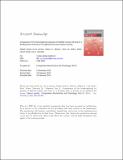Files in this item
Comparison of the transcriptional responses of skeletal muscle and bone to a flooding dose of leucine in the gilthead sea bream (Sparus aurata)
Item metadata
| dc.contributor.author | Garcia de la Serrana, Daniel | |
| dc.contributor.author | Mareco, Edson A. | |
| dc.contributor.author | Vieira, Vera L. A. | |
| dc.contributor.author | Power, Deborah M. | |
| dc.contributor.author | Johnston, Ian A. | |
| dc.date.accessioned | 2017-02-27T00:32:46Z | |
| dc.date.available | 2017-02-27T00:32:46Z | |
| dc.date.issued | 2016-09 | |
| dc.identifier | 241247502 | |
| dc.identifier | 65ec1405-92e2-40ff-8d6e-02e1d3c56837 | |
| dc.identifier | 84960982219 | |
| dc.identifier | 000383820500007 | |
| dc.identifier.citation | Garcia de la Serrana , D , Mareco , E A , Vieira , V L A , Power , D M & Johnston , I A 2016 , ' Comparison of the transcriptional responses of skeletal muscle and bone to a flooding dose of leucine in the gilthead sea bream ( Sparus aurata ) ' , Comparative Biochemistry and Physiology - Part B: Biochemistry and Molecular Biology , vol. 199 , pp. 50-57 . https://doi.org/10.1016/j.cbpb.2016.02.003 | en |
| dc.identifier.issn | 1096-4959 | |
| dc.identifier.other | Bibtex: urn:3858f89942e0e2ff58c640e3789e0ebc | |
| dc.identifier.other | ORCID: /0000-0002-7796-5754/work/47136005 | |
| dc.identifier.uri | https://hdl.handle.net/10023/10371 | |
| dc.description | This research was funded by the European Community's Seventh Framework program (FP7/2007–2013) under grant agreement No 222,719- LIFECYCLE and by an EU Research Infrastructure Action under the FP7 “Capacities” Programme, ASSEMBLE (no. 227,799, CCMAR Ref 00,215/2011) and by the Marine Science & Technology pooling initiative and Scottish Funding Council grant HR09011 and contributing institutions. | en |
| dc.description.abstract | Skeletal muscle, cartilage and bone must function in a co-ordinated fashion during locomotion and growth. In the present study on the gilthead sea bream (Sparus aurata) we tested the hypothesis that muscle and bone differ in their responsiveness to stimuli eliciting fast growth, providing a potential mechanism for generating the skeletal deformities observed in aquaculture. To investigate transcription regulation in skeletal muscle and bone we stimulated protein synthesis using a flooding dose of the branched chain amino acid leucine and compared the results with saline-injected controls. To increase the amount of available sequence information for gene expression analysis a de novo transcriptome was assembled using publicly available Next Generation Sequencing libraries from embryo, fast skeletal muscle, bone and cartilage. The resulting 5 million reads were assembled into 125,646 isotigs representing around 16,000 unique genes, including most components of the Pi3k/Akt/mTor signalling pathway. Principal Components Analysis was able to distinguish the transcriptional responses between leucine and saline injected controls in skeletal muscle, but not in bone. General Linear Modelling revealed significant temporal changes in gene expression following leucine injection including the tissue-specific markers sparc, bglap (bone), mlc2 and myod2 (muscle) and gene transcripts associated with Pi3k/Akt/mTor signalling, p70sk6, akt2, ampka and mtor. Skeletal muscle showed more pronounced and rapid changes in transcript abundance than bone to the same pro-growth signal. The observed differences in transcriptional response are consistent with the idea that fast growth results in a miss-match between muscle and bone development and may contribute to a higher incidence of skeletal deformities. | |
| dc.format.extent | 7 | |
| dc.format.extent | 1013884 | |
| dc.language.iso | eng | |
| dc.relation.ispartof | Comparative Biochemistry and Physiology - Part B: Biochemistry and Molecular Biology | en |
| dc.subject | NGS | en |
| dc.subject | Muscle | en |
| dc.subject | Bone | en |
| dc.subject | Expression | en |
| dc.subject | Leucine | en |
| dc.subject | mTOR | en |
| dc.subject | Fast growth | en |
| dc.subject | Aquaculture | en |
| dc.subject | Skeletal deformities | en |
| dc.subject | QH301 Biology | en |
| dc.subject | SH Aquaculture. Fisheries. Angling | en |
| dc.subject.lcc | QH301 | en |
| dc.subject.lcc | SH | en |
| dc.title | Comparison of the transcriptional responses of skeletal muscle and bone to a flooding dose of leucine in the gilthead sea bream (Sparus aurata) | en |
| dc.type | Journal article | en |
| dc.contributor.sponsor | European Commission | en |
| dc.contributor.institution | University of St Andrews. School of Biology | en |
| dc.contributor.institution | University of St Andrews. Marine Alliance for Science & Technology Scotland | en |
| dc.contributor.institution | University of St Andrews. Scottish Oceans Institute | en |
| dc.contributor.institution | University of St Andrews. Centre for Research into Ecological & Environmental Modelling | en |
| dc.identifier.doi | 10.1016/j.cbpb.2016.02.003 | |
| dc.description.status | Peer reviewed | en |
| dc.date.embargoedUntil | 2017-02-26 | |
| dc.identifier.grantnumber | IJBO14 | en |
This item appears in the following Collection(s)
Items in the St Andrews Research Repository are protected by copyright, with all rights reserved, unless otherwise indicated.

